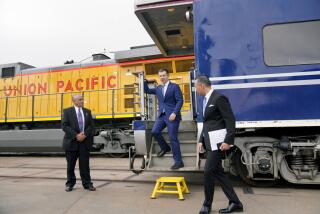SEAL BEACH : Electric Red Cars Put City on Track
Back when the town was known as Bay City and a Ferris wheel towered by the seashore, Red Cars ferried tourists from inland areas to the âConey Island of the West.â
For more than 40 years, the Pacific Electric Red Cars provided a vital service to Orange County.
To help preserve memories of those days, the Seal Beach Historical Society bought and refurbished a Red Car in the late 1970s and opened a museum at the corner of Electric Avenue and Main Street.
âOur car was a maintenance car for the line,â said Eloise Shank, president of the historical society. âWith a lot of volunteer help, we were able to restore it. At that time, it was decided to put it on the site of the old tracks.â
The museum, open on Saturdays from 1 to 4 p.m., houses photographs, period clothing, newspaper clippings, sea shells and other memorabilia.
The greenbelt on which it sits is the old right of way for the Red Cars that provided a crucial link between Seal Beach and the rest of Southern California.
Henry E. Huntington began operating the Red Cars in the early 1900s, touting them as the transportation of the future because they ran on clean, quiet electricity. The first link to Orange County, the Long Beach line, reached Bay City in 1902.
The first Red Car pulled into Huntington Beach in 1904. By 1906, the line extended to Balboa. Lines to inland areas soon followed, and wherever the Red Cars went, land prices skyrocketed and the economy boomed.
Red Cars were one of the primary reasons Seal Beach, Huntington Beach and Newport Beach became playgrounds for the inland masses and lured the well-to-do, who built vacation homes on tiny lots that still define Old Town Seal Beach and Balboa Peninsula.
Many who rode the Red Cars remember them fondly. Bruce Frensinger, a member of the historical society and an avid railroad buff, has had a love affair with Red Cars since he rode them from his home in Arcadia to Los Angeles as a child.
âI was sorry and surprised to see them go,â Frensinger said. âOf course when youâre small and you see things there, you think theyâll be there forever.â
Instead, as the popularity of the automobile grew, Red Cars became obsolete and were eventually shut down.
But the concept of a rail system providing a link never really died and now, following Los Angelesâ lead, Orange County transportation officials are working to bring an urban rail system back to the county.
The Orange County Transportation Authority board adopted a long-range plan in October that outlines a goal to build an initial 47-mile urban rail network in the next 20 years. The network would include a north-south line and an east-west line as well.
Much of the line would be elevated and automated, eliminating the conflict with auto traffic that the Red Cars had, said Brian Pearson, director of rail programs for OCTA.
The problem now is financial.
âOur intent is to make it a reality, but we lack capital funding,â Pearson said. Preliminary cost estimates for the network are $2.2 billion, he said.
More to Read
Sign up for Essential California
The most important California stories and recommendations in your inbox every morning.
You may occasionally receive promotional content from the Los Angeles Times.










